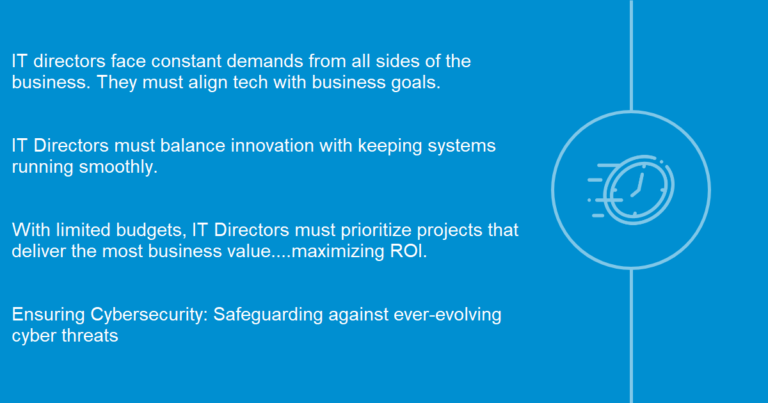
As an IT Director, you wear many hats…which is an understatement. You’re expected to be a security expert, project manager, budget guru, help desk hero, and technology visionary – all while battling endless interruptions.
It’s no wonder an IT Director feels spread impossibly thin, juggling competing priorities amidst limited resources and time.
However, delegation is a skill that can empower IT Directors and leaders to take back control and achieve more strategic impact without abandoning their team.
This article aims to explain the art of IT delegation, presenting strategic insights and tangible tactics specifically crafted for an IT Director.
It’s not just about delegating tasks; it’s about transforming IT leadership.
Here, we offer advice and a roadmap to help you be more productive and successful.
Before diving into practical delegation strategies, it’s important to recognize common actions that derail success:
Once you delegate a task, hovering and controlling every step is tempting. But this erodes employees’ sense of ownership. Give space to figure things out.
Leaving goals, deadlines, and scope open to interpretation leads to missed objectives. Set crystal clear expectations upfront.
When an IT Director assigns a task to those lacking the required abilities, it is a recipe for mediocrity. Analyze strengths and gaps first.
Tossing work to team members without preparation breeds anxiety and frustration. Invest time in training.
If delegated tasks occur in silos, coordination suffers. Facilitate transparency and access.
You must verify work meets standards, offer feedback, and tie rewards to outcomes. Accountability is critical. Once you know common pitfalls, avoiding them with a mindful strategy is easier.

Obviously, you understand your job very well, but being spread too thin, you may be too close to things to get a clear picture of what is happening.
An overwhelming collection of responsibilities is at the core for an IT Director. The scope of their duties is extensive, from safeguarding the company’s digital assets against ever-growing cyber threats to ensuring the seamless integration of new technologies.
Each decision, from software procurement to network architecture, impacts the organization’s efficiency and security.
By categorizing your tasks into ‘core’ and ‘non-core’ and auditing how you spend your time, you can pinpoint what to delegate.
Effective delegation starts with crystal-clear expectations. Specify goals, quality standards, deadlines, processes, and checkpoints.
Emphasize the importance of context and understanding the ‘why’ behind the ‘what.’ Clear, written communication is vital to eliminate confusion.

Over-commitment is a common difficulty for an IT Director, and often leads to negative consequences. Burnout, diminished quality of work, and an inability to focus on strategic initiatives are just a few.
When an IT Director is overburdened, it’s not just their performance that suffers – it affects the team’s morale, the department’s productivity, and ultimately, the organization’s technological progress.
Overcome the fear of losing control or diluting quality by building trust and appreciating diverse skill sets.
Embrace delegation as a strategic efficiency tool, not a weakness.
As an IT Director or leader, learn to accept different yet successful task approaches.
Articulate tasks, outcomes, and timelines.
Balance freedom with guidance to foster innovation and problem-solving.
Tools like Asana, Trello, or Jira can streamline delegation.
Automation frees time for more strategic work.

For an IT Director, delegation and internal reallocation only goes so far. Critical capability gaps emerge as business needs rapidly evolve and chronic understaffing persists. Turning to an external expert partner can provide relief.
A co-managed IT model blends the best of internal and external resources. Your organization controls critical on-premises systems, while a managed service provider handles specialized functions or temporary initiatives cost-effectively.
This agile arrangement allows quickly scaling capabilities up or down as needs change.
You avoid costly full-time hires for temporary projects or niche skills. Instead, leverage your partner’s pre-assembled teams of experts who seamlessly plug into your existing environment – your on-demand talent bench.
Managed service providers bring extensive expertise from supporting diverse clients in your industry. Are new cloud security regulations overwhelming your internal team? Does M&A integration require niche middleware skills? An experienced partner has seen it all.
Co-managed IT provides access to full-stack technical specialists, project managers, senior strategists, and other roles to fill any skill or bandwidth gaps – without compromising your vision. Consider it supplemental brainpower.
It also enables internal IT staff to refocus on truly differentiating priorities and innovations – where they have unmatched institutional knowledge and strategic value. Optimize their time on high-impact initiatives rather than spread them thin, trying to operate as generalists.
Let your partner take the baseline blocking and tackling off your plate – infrastructure maintenance, help desk, business continuity, etc. Eliminate constant context switching.
Assessing potential Co-Managed IT partners involves deep evaluation beyond a standard vendor selection. Consider compatibility with your environment, cultural fit, change management prowess, proven best practices, and breadth of services offered.
Verify they can seamlessly integrate with your workflows as a collaborative provider, not just a contractor. Your engagement model must align for a fruitful long-term partnership.
While relinquishing some control may feel uncomfortable initially, the right co-management partner becomes a transparent extension of your team – a multiplier of your outcomes.
Technical debt is a lurking threat that can undermine service levels, increase risks, and restrain innovation. However, administrators who tackle it strategically can transform their technology into an asset for positive change.
With assessment, communication, and proactive management, technical debt can be handled like any other balance sheet liability. Pay it down through dedicated resources and diligent governance, and its drag will lift – making way for agile systems that help drive your city or county forward.
Next Steps:
If you would like to learn more about technical debt, check out this full guide we created for leaders:
If you have more immediate concerns or needs, reach out, and we can do a full assessment of your current infrastructure.
Lorem ipsum dolor sit amet, consectetur adipiscing elit. Ut elit tellus, luctus nec ullamcorper mattis, pulvinar dapibus leo.